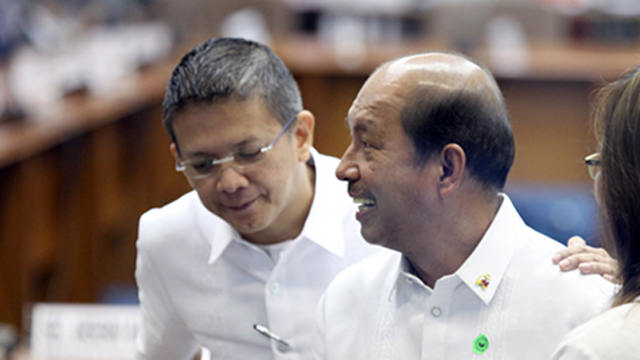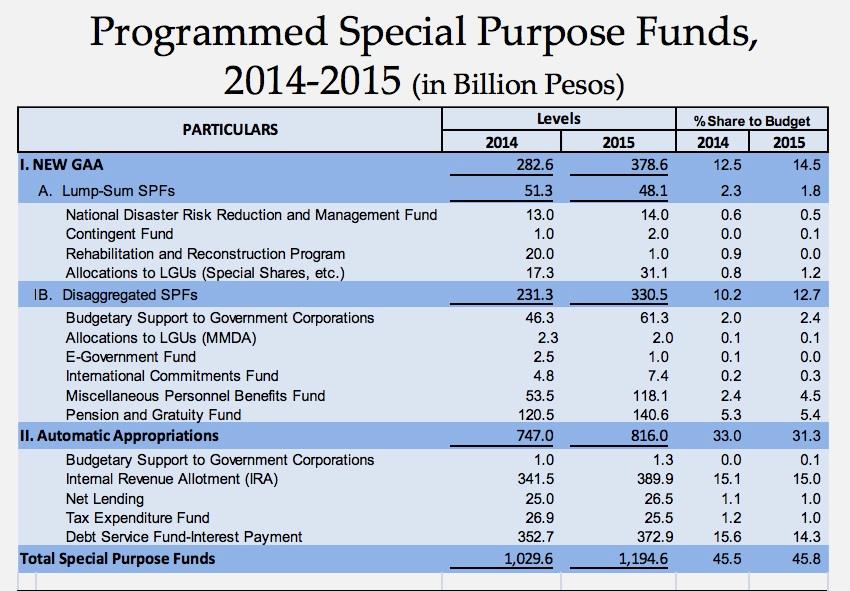SUMMARY
This is AI generated summarization, which may have errors. For context, always refer to the full article.

MANILA, Philippines – “Payag po kami [disaggregated ang lump sums.] Basta sabihin niyo kung ilang bagyo ang dadating sa bansa!” (We agree with the call to disaggregate lump sums. Just tell us how many typhoons will hit the country!)
This was the response of Senate President Franklin Drilon to the debate about lump sums or funds without detailed expenditures in the 2015 national budget. Budget watchdogs warned against the possible abuse of the lump sums in a pre-election year after the Supreme Court struck down the congressional pork barrel.
Senators said they will demand details and answers on lump sums when the chamber begins hearings on the P2.606 trillion ($59.57 billion*) proposed budget or General Appropriations Act (GAA) for 2015 on Tuesday, August 19.
Is there such a thing as a budget without a lump sum? What can be done to make the budget more transparent? What else do senators plan to scrutinize?
‘More details, breakdown’
Drilon’s line stems from the argument that the executive branch needs flexibility in budget execution. Balancing flexibility, Congress’ power of the purse, and calls for more transparency will be a key debate in the budget hearings, especially after the Court ruling against key acts under the administration’s special spending measure, the Disbursement Acceleration Program (DAP). (READ: Chiz to set ground rules on savings in budget and Revisit all laws on public spending – Angara)
How much are the lump sums in the budget? Budget Secretary Florencio Abad and advocacy group Social Watch Philippines (SWP) have different figures.
By the estimates of SWP lead convenor Professor Leonor Briones, “practically half” of next year’s budget consists of lump sums and automatic appropriations. Here, she included automatic appropriations, the President’s Special Purpose Funds (SPF), unprogrammed expenditures, the Internal Revenue Allotment, and debt servicing.
To SWP, it is better to increase allocations to agencies for social development like health, education and employment in place of “massive amounts in lump sums.” This way, agencies can report on the expenditures, making funds easier to trace.
Yet in a statement from the Department of Budget and Management (DBM), Abad said only P48.1 billion ($1.10 billion) are lump sums under the SPF.
His presentation to the House of Representatives showed that the lump sums under the Special Purpose Funds include the National Disaster Risk Reduction and Management Fund or calamity fund, the Contingent Fund, Rehabilitation and Reconstruction Program, and Allocations to LGUs or local government units.

“Items that are strictly lump-sums represent only 1.8% of total SPFs. The nature of these lump-sum items is such that they are impossible to disaggregate or break down into specific items until the budget is actually being implemented,” Abad added.
Senate finance committee chairman Francis Escudero agreed with Abad and Drilon that some funds in the budget that cannot be broken down during budget preparations, particularly those concerning future disasters.
Still, Escudero said there are items like the allocation for LGUs where the DBM and other agencies can still give more details. He warned that he will slash the budget of agencies that do not submit “itemized breakdowns.”
Opposition Senator Nancy Binay said she too wants more details.
“We will study the items that should be given priority and allocations that do not have a clear program. Of course, we also have to review and dissect every line where insertions are possible and take consideration issues raised by Professor Briones,” she told Rappler on Friday, August 15.
Senator Bam Aquino, the President’s cousin, pointed out that the administration already made efforts to break down lump sums. “Compared to previous iterations, this year’s budget has even less lump sums and more detailed items, but of course, we will still have to check on what is currently still present.”
Focus on social services
Besides the lump sums, senators are focusing on sectors and programs related to their advocacies. Many of them told Rappler they will zero in on the budget for social services.
In his budget message, President Benigno Aquino III said social services got a “lion’s share” or 37.1% of the budget worth P967.9 billion ($22.16 billion). In comparison, Aquino said the share of social services in 2005 was just 27% of the budget.
Senator Juan Edgardo “Sonny” Angara has called this an “underrated legacy” of the administration and said he plans to again look into the budget for education, health, and “crucial infrastructure” in 2015.
Senator Grace Poe is focusing on the budget for the Department of Education’s lunch program for malnourished children in public elementary schools.
“My priority is that DepEd will be able to explain in detail how this will be implemented and monitored. The same goes for the DSWD’s (Department of Social Welfare and Development) feeding program in their Day Cay centers,” said the senator who filed a bill pushing for a lunch program for children.
Trillanes vs K to 12; Sotto vs RH
Senator Antonio Trillanes IV will prioritize the budget for the K to 12 program, which adds two years to the basic education system to help students be globally competitive. The senator has criticized the program and called for its suspension.
“I firmly believe that for us to be fully prepared by 2016, we need to pour in hundreds of billions for construction of classrooms and laboratories, procurement of lab equipment, production of learning materials, hiring and training of hundreds of thousands of teachers, subsidies for college professors and staff who would be dislocated, and subsidies to indigent parents who won’t be able to afford extending their kids’ education for two more years,” he told Rappler.
Aquino said in his budget message that 39,066 more teachers will be hired, and 31,728 classrooms will be constructed in 2015 to support the K to 12 program.
On health, P3.3 billion ($75.57 million) was allocated to implement the Reproductive Health (RH) Law, especially in providing vitamin A supplements for children below the age of 5, and “family planning commodities” to women and services to LGUs.
This comes after the Court lifted the restraining order on the landmark law in April, a year after the measure’s implementation was delayed.
Senator Vicente “Tito” Sotto III, a staunch RH critic, said he will again scrutinize the budget for the RH law, “particularly the family planning commodities.”
With the budget season underway, Senate President Pro Tempore Ralph Recto said lawmakers should not just focus on budget preparations but ask for an accounting of the funds after the passage of the budget.
The former socio-economic planning secretary proposed that the executive branch return the GAA to Congress, with “status reports” written in annotated form.
“The beauty of this approach is that lump-sum funds can be disaggregated. For example, Calamity Fund is a block fund but under my proposal, this will be itemized in the post-budget reporting where it went,” Recto said. – Rappler.com
Add a comment
How does this make you feel?
There are no comments yet. Add your comment to start the conversation.